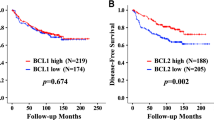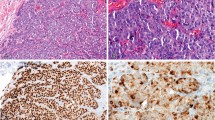Abstract
The c-erbB-2 gene codes for a putative transmembrane protein, similar in structure to the epidermal growth factor (EGF) receptor. Amplification of the gene has been described in a variety of human adenocarcinomas and is particularly well documented in breast carcinoma. It has been suggested that amplification is indicative of poor prognosis and, as such, is comparable with lymph node status as a predictor of clinical outcome. This study examines the suggestion indirectly by an immunohistochemical technique. Archival tissue from 195 patients with primary breast carcinoma was stained with the polyclonal antibody 21N, raised to amino acids 1243-1255, the C-terminus of the predicted amino acid sequence of the c-erbB-2 protein. Up to 10 year verified follow-up data were available on all patients. Staining compatible with significant amplification was observed in 17 patients. Using the chi-squared test for trend a significant correlation was found between staining and grade (P = 0.04) but not with either node or receptor status. No significant association was found between staining and clinical outcome although there was a tendency for patients with stained tumours to have a worse prognosis. A Cox regression analysis was used to adjust for node status and grade and still no correlation was revealed between staining and prognosis. However a study of this size in which only a small number of patients have been found to have stained tumours does have wide confidence limits. Comparable staining observed in in situ and infiltrating components of tumours suggests that amplification is an early event in carcinogenesis. Similar staining in primary and subsequent metastatic lesions was also noted. It is considered that further studies at both the DNA/mRNA and protein levels are required to confirm the significance of c-erbB-2 amplification in human breast carcinoma.
This is a preview of subscription content, access via your institution
Access options
Subscribe to this journal
Receive 24 print issues and online access
$259.00 per year
only $10.79 per issue
Buy this article
- Purchase on Springer Link
- Instant access to full article PDF
Prices may be subject to local taxes which are calculated during checkout
Similar content being viewed by others
Author information
Authors and Affiliations
Rights and permissions
About this article
Cite this article
Barnes, D., Lammie, G., Millis, R. et al. An immunohistochemical evaluation of c-erbB-2 expression in human breast carcinoma. Br J Cancer 58, 448–452 (1988). https://doi.org/10.1038/bjc.1988.238
Issue Date:
DOI: https://doi.org/10.1038/bjc.1988.238
This article is cited by
-
Invasive lobular carcinoma of the breast: long-term prognostic value of Ki67 and histological grade, alone and in combination with estrogen receptor
SpringerPlus (2014)
-
HER2 status of bone marrow micrometastasis and their corresponding primary tumours in a pilot study of 27 cases: a possible tool for anti-HER2 therapy management?
British Journal of Cancer (2007)
-
HER2 protein overexpression in estrogen receptor-positive ductal carcinoma in situ of the breast: frequency and implications for tamoxifen therapy
Modern Pathology (2005)
-
Immunohistochemical expression of uPA, PAl-1, cathepsin D and apoptotic cells in ductal carcinomain situ of the breast
Breast Cancer (2002)
-
Significance of immunohistochemical c-ErbB-2 product localisation pattern for prognosis in human breast cancer
Pathology & Oncology Research (2001)



